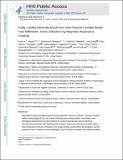| dc.contributor.author | Nguyen, Hung VanThanh | |
| dc.contributor.author | Zhang, Hui | |
| dc.contributor.author | Harvey, Peter | |
| dc.contributor.author | Yan, Changcun | |
| dc.contributor.author | Mathieu, Clelia | |
| dc.contributor.author | Golder, Matthew R | |
| dc.contributor.author | Jiang, Yivan | |
| dc.contributor.author | Ottaviani, Maria Francesca | |
| dc.contributor.author | Jasanoff, Alan Pradip | |
| dc.contributor.author | Rajca, Andrzej | |
| dc.contributor.author | Ghobrial, Irene | |
| dc.contributor.author | Ghoroghchian, Paiman Peter | |
| dc.contributor.author | Johnson, Jeremiah A. | |
| dc.date.accessioned | 2020-01-22T18:11:14Z | |
| dc.date.available | 2020-01-22T18:11:14Z | |
| dc.date.issued | 2018-11-02 | |
| dc.date.submitted | 2018-08-13 | |
| dc.identifier.issn | 1936-0851 | |
| dc.identifier.issn | 1936-086X | |
| dc.identifier.uri | https://hdl.handle.net/1721.1/123532 | |
| dc.description.abstract | Nitroxides occupy a privileged position among plausible metal-free magnetic resonance imaging (MRI) contrast agents (CAs) due to their inherently low-toxicity profiles; nevertheless, their translational development has been hindered by a lack of appropriate contrast sensitivity. Nanostructured materials with high nitroxide densities, where each individual nitroxide within a macromolecular construct contributes to the image contrast, could address this limitation, but the synthesis of such materials remains challenging. Here, we report a modular and scalable synthetic approach to nitroxide-based brush-arm star polymer (BASP) organic radical CAs (ORCAs) with high nitroxide loadings. The optimized -30 nm diameter "BASP-ORCA3" displays outstanding T₂ sensitivity with a very high molecular transverse relaxivity (r₂ > 1000 mM⁻¹ s⁻¹). BASP-ORCA3 further exhibits excellent stability in vivo, no acute toxicity, and highly desirable pharmacokinetic and biodistribution profiles for longitudinal detection of tumors by MRI. When injected intravenously into mice bearing subcutaneous plasmacytomas, BASP-ORCA3 affords distinct in vivo visualization of tumors on translationally relevant time scales. Leveraging its high sensitivity, BASP-ORCA3 enables efficient mapping of tumor necrosis, which is an important biomarker to predict therapeutic outcomes. Moreover, BASP-ORCA3 allows for detection of millimetric tumor implants in a disseminated murine model of advanced-stage human ovarian cancer that possess genetic, histological, and vascular characteristics that are similar to those seen in patients. This work establishes BASP-ORCA3 as a promising metal-free spin contrast agent for MRI. Keywords: magnetic resonance imaging; nitroxide; ring-opening metathesis polymerization; star polymers; cancer | en_US |
| dc.description.sponsorship | National Institute of Health (U.S.) (U01-NS090451) | en_US |
| dc.description.sponsorship | National Institute of Health (U.S.) (1R01CA220468-01) | en_US |
| dc.description.sponsorship | National Cancer Institute (U.S.) (1R01CA220468-01) | en_US |
| dc.description.sponsorship | National Cancer Institute (U.S.) (Koch Institute Support Grant P30-CA14051) | en_US |
| dc.language.iso | en | |
| dc.publisher | American Chemical Society | en_US |
| dc.relation.isversionof | https://doi.org/10.1021/acsnano.8b06160 | en_US |
| dc.rights | Article is made available in accordance with the publisher's policy and may be subject to US copyright law. Please refer to the publisher's site for terms of use. | en_US |
| dc.source | PMC | en_US |
| dc.title | Triply Loaded Nitroxide Brush-Arm Star Polymers Enable Metal-Free Millimetric Tumor Detection by Magnetic Resonance Imaging | en_US |
| dc.type | Article | en_US |
| dc.identifier.citation | Nguyen, Hung V.-T. "Triply Loaded Nitroxide Brush-Arm Star Polymers Enable Metal-Free Millimetric Tumor Detection by Magnetic Resonance Imaging." ACS Nano, 12, 11, (November 2018): 11343-11354 © 2018 American Chemical Society | en_US |
| dc.contributor.department | Massachusetts Institute of Technology. Department of Chemistry | en_US |
| dc.contributor.department | Massachusetts Institute of Technology. Department of Biological Engineering | en_US |
| dc.contributor.department | Massachusetts Institute of Technology. Department of Brain and Cognitive Sciences | en_US |
| dc.contributor.department | Massachusetts Institute of Technology. Department of Nuclear Science and Engineering | en_US |
| dc.contributor.department | Koch Institute for Integrative Cancer Research at MIT | en_US |
| dc.relation.journal | ACS Nano | en_US |
| dc.eprint.version | Author's final manuscript | en_US |
| dc.type.uri | http://purl.org/eprint/type/JournalArticle | en_US |
| eprint.status | http://purl.org/eprint/status/PeerReviewed | en_US |
| dc.date.updated | 2019-12-20T16:47:05Z | |
| dspace.date.submission | 2019-12-20T16:47:11Z | |
| mit.journal.volume | 12 | en_US |
| mit.journal.issue | 11 | en_US |
| mit.metadata.status | Complete | |
